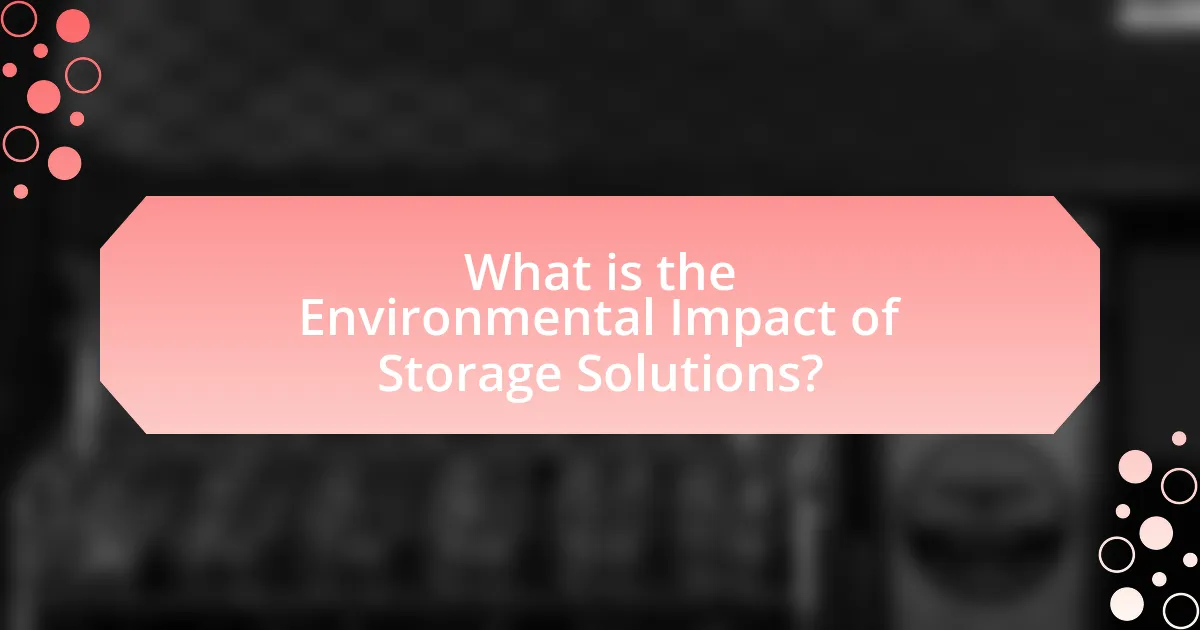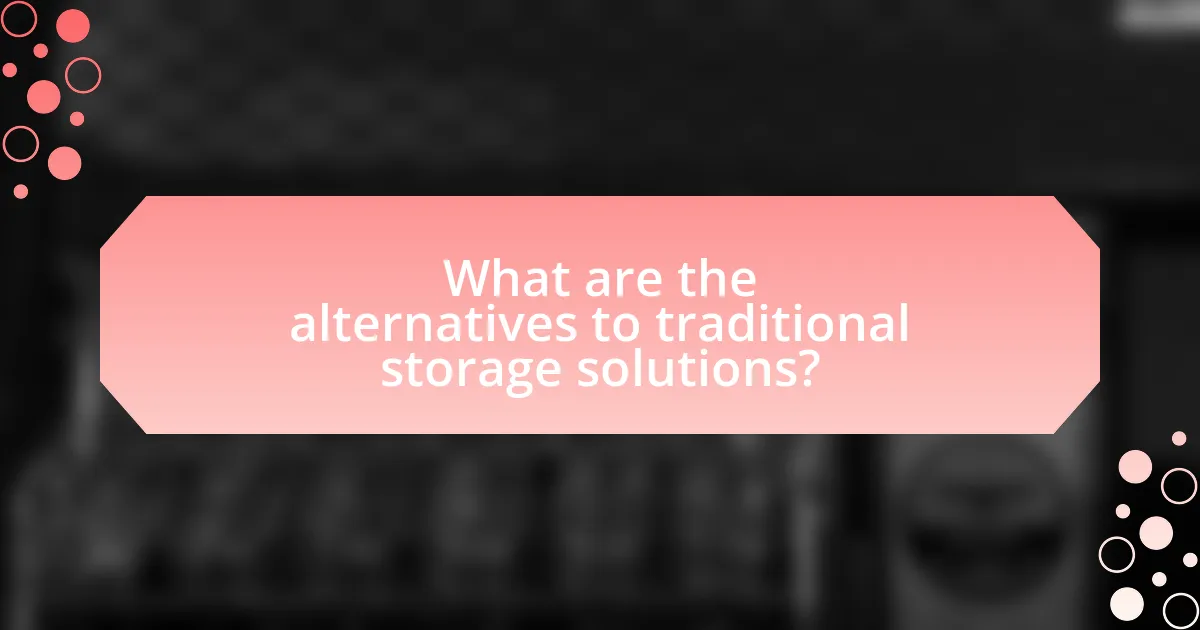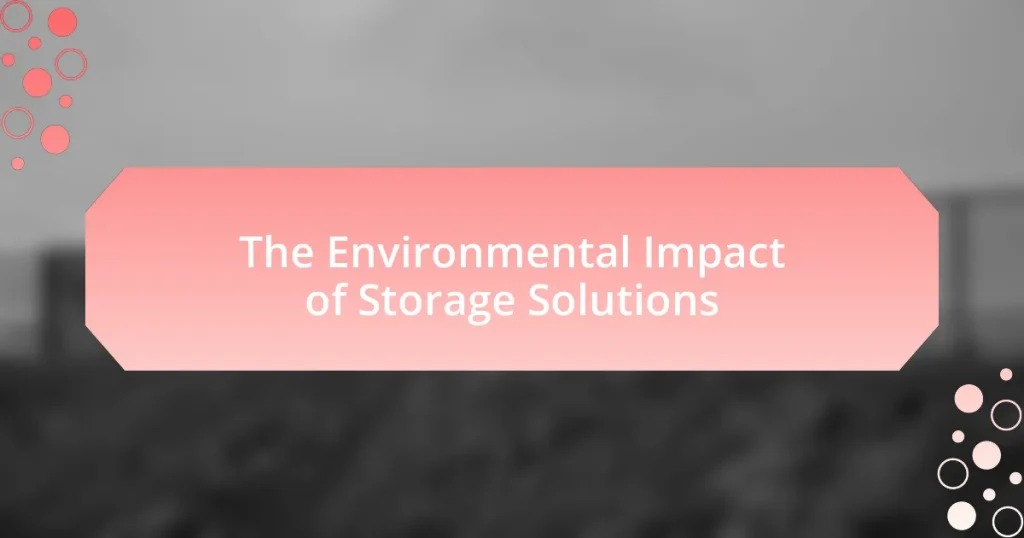The article examines the environmental impact of storage solutions, focusing on energy consumption, resource use, and waste generation associated with various storage methods, particularly in data centers. It highlights how the production and disposal of storage materials contribute to pollution and habitat destruction, emphasizing the importance of sustainable practices. Key pollutants, effects on local ecosystems, and factors influencing the environmental footprint of storage solutions are discussed, along with strategies for mitigation and the benefits of eco-friendly alternatives. The article also explores innovative technologies and best practices for reducing the environmental impact of storage systems.
What is the Environmental Impact of Storage Solutions?

 |
|
The environmental impact of storage solutions primarily involves energy consumption, resource use, and waste generation. Storage solutions, particularly in data centers, require significant electricity for operation and cooling, contributing to greenhouse gas emissions. For instance, a study by the International Energy Agency reported that data centers consumed about 1% of global electricity in 2020, with projections indicating this could rise as digital storage needs increase. Additionally, the production of physical storage devices, such as hard drives, involves mining and processing raw materials, which can lead to habitat destruction and pollution. Furthermore, improper disposal of electronic storage devices can result in hazardous waste, as they often contain toxic substances. Thus, while storage solutions are essential for modern infrastructure, their environmental impact necessitates careful management and sustainable practices.
How do storage solutions contribute to environmental degradation?
Storage solutions contribute to environmental degradation primarily through the production and disposal of materials used in their construction, which often involves non-renewable resources and generates waste. The manufacturing processes for storage systems, such as plastic containers or metal shelving, typically require significant energy and raw materials, leading to greenhouse gas emissions and resource depletion. For instance, the production of plastic involves petroleum extraction and refining, which can result in habitat destruction and pollution. Additionally, when these storage solutions reach the end of their life cycle, improper disposal can lead to landfill overflow and leaching of harmful substances into the soil and water systems, further exacerbating environmental issues.
What specific pollutants are associated with storage solutions?
Specific pollutants associated with storage solutions include volatile organic compounds (VOCs), heavy metals, and particulate matter. VOCs are often emitted from materials used in storage systems, such as plastics and paints, contributing to air pollution and potential health risks. Heavy metals, such as lead and mercury, can leach from improperly managed storage containers, contaminating soil and water sources. Particulate matter can arise from the degradation of storage materials or from dust generated during the handling of stored items, impacting air quality and respiratory health.
How do storage solutions affect local ecosystems?
Storage solutions can significantly impact local ecosystems by altering land use, affecting water resources, and influencing biodiversity. For instance, the construction of large storage facilities often requires land clearing, which can lead to habitat destruction and fragmentation, negatively affecting local wildlife populations. Additionally, these facilities may change the natural flow of water, leading to issues such as increased runoff and potential contamination of local water sources. Research indicates that habitat loss due to industrial storage developments can result in a decline of native species, as seen in studies conducted in various regions where such facilities have been established.
What are the key factors influencing the environmental impact of storage solutions?
The key factors influencing the environmental impact of storage solutions include energy consumption, material sourcing, lifecycle emissions, and end-of-life disposal. Energy consumption is critical as storage systems, particularly in data centers, can account for a significant portion of total energy use, with estimates suggesting that data centers consume about 1% of global electricity. Material sourcing affects the environmental footprint, as the extraction and processing of materials for batteries or other storage technologies can lead to habitat destruction and pollution. Lifecycle emissions, which encompass emissions from production, operation, and disposal, are essential to consider; for instance, lithium-ion batteries have a carbon footprint that varies significantly based on the energy mix used in their production. Finally, end-of-life disposal practices, such as recycling or landfill, greatly influence the overall environmental impact, with improper disposal leading to hazardous waste and resource loss.
How does the material used in storage solutions affect their environmental footprint?
The material used in storage solutions significantly affects their environmental footprint by influencing resource consumption, energy use, and end-of-life disposal. For instance, materials like plastic and metal require substantial energy for production and contribute to greenhouse gas emissions, while biodegradable materials can reduce long-term environmental impact. According to a study by the Ellen MacArthur Foundation, the production of plastic contributes to approximately 3.8% of global greenhouse gas emissions, highlighting the environmental cost associated with plastic storage solutions. Additionally, the recyclability of materials plays a crucial role; materials that can be easily recycled, such as certain metals and glass, tend to have a lower environmental footprint compared to those that are not recyclable.
What role does energy consumption play in the environmental impact of storage solutions?
Energy consumption significantly influences the environmental impact of storage solutions by determining the carbon footprint associated with their operation. High energy usage in storage systems, particularly those reliant on fossil fuels, leads to increased greenhouse gas emissions, contributing to climate change. For instance, data centers, which are critical for cloud storage, consume about 200 terawatt-hours of electricity annually, accounting for approximately 1% of global energy demand. This substantial energy requirement not only affects resource depletion but also exacerbates air pollution and environmental degradation. Therefore, the energy consumption of storage solutions is a crucial factor in assessing their overall environmental sustainability.
Why is it important to assess the environmental impact of storage solutions?
Assessing the environmental impact of storage solutions is crucial because it helps identify and mitigate negative effects on ecosystems and human health. Storage solutions, such as batteries and data centers, can contribute to pollution, resource depletion, and greenhouse gas emissions. For instance, the production of lithium-ion batteries for energy storage involves mining processes that can lead to habitat destruction and water contamination. Furthermore, data centers consume significant amounts of energy, often sourced from fossil fuels, which exacerbates climate change. By evaluating these impacts, stakeholders can make informed decisions that promote sustainability, reduce carbon footprints, and enhance resource efficiency.
What are the long-term consequences of neglecting environmental assessments?
Neglecting environmental assessments can lead to severe long-term consequences, including irreversible ecological damage, public health risks, and economic losses. When environmental assessments are overlooked, projects may disrupt local ecosystems, resulting in habitat destruction and loss of biodiversity. For instance, the failure to assess the impact of industrial waste disposal has led to contaminated water sources, which can cause long-term health issues for communities relying on that water. Additionally, the lack of proper assessments can result in costly remediation efforts later, as seen in cases like the Love Canal disaster, where neglecting environmental evaluations led to significant cleanup costs and health crises. Overall, the absence of environmental assessments can create a cycle of environmental degradation, health hazards, and financial burdens that persist for generations.
How can understanding the environmental impact lead to better storage practices?
Understanding the environmental impact can lead to better storage practices by informing decision-makers about the sustainability of materials and methods used in storage solutions. When organizations recognize the carbon footprint and resource consumption associated with various storage options, they can choose eco-friendly materials, optimize space utilization, and implement energy-efficient systems. For instance, a study by the Environmental Protection Agency indicates that using recycled materials in storage can reduce waste and lower greenhouse gas emissions, thereby promoting more sustainable practices.
How can we mitigate the environmental impact of storage solutions?
To mitigate the environmental impact of storage solutions, organizations can adopt energy-efficient technologies and sustainable materials. Implementing energy-efficient data centers reduces electricity consumption, as evidenced by a report from the U.S. Department of Energy, which states that energy-efficient practices can cut energy use by up to 30%. Additionally, utilizing renewable energy sources, such as solar or wind power, further decreases carbon footprints associated with storage operations. Transitioning to solid-state drives (SSDs) instead of traditional hard disk drives (HDDs) can also enhance energy efficiency, as SSDs consume less power and have a longer lifespan. Furthermore, optimizing data storage through deduplication and compression techniques minimizes the physical storage space required, leading to reduced resource consumption.
What sustainable materials can be used in storage solutions?
Sustainable materials that can be used in storage solutions include bamboo, recycled metal, reclaimed wood, and organic cotton. Bamboo is a fast-growing grass that requires minimal resources and is biodegradable, making it an eco-friendly choice. Recycled metal, such as aluminum, reduces the need for new raw materials and energy consumption in production. Reclaimed wood repurposes existing timber, minimizing deforestation and waste. Organic cotton, often used in fabric storage solutions, is grown without harmful pesticides, promoting environmental health. These materials collectively contribute to reducing the environmental impact of storage solutions by utilizing renewable resources and minimizing waste.
How can energy efficiency be improved in storage solutions?
Energy efficiency in storage solutions can be improved by implementing advanced technologies such as high-efficiency batteries, optimized thermal management systems, and smart energy management software. High-efficiency batteries, like lithium-ion and solid-state batteries, offer higher energy density and longer life cycles, reducing energy loss during storage and discharge. Optimized thermal management systems maintain optimal operating temperatures, which enhances battery performance and longevity, thereby minimizing energy waste. Smart energy management software utilizes algorithms to optimize charging and discharging cycles based on demand and usage patterns, further increasing overall efficiency. According to a study by the National Renewable Energy Laboratory, improving battery efficiency can lead to a reduction in energy losses by up to 30%, demonstrating the significant impact of these technologies on energy efficiency in storage solutions.
What are the alternatives to traditional storage solutions?

 |
|
Cloud storage, solid-state drives (SSDs), and hybrid storage solutions are key alternatives to traditional storage solutions. Cloud storage allows users to store data on remote servers accessed via the internet, providing scalability and reducing the need for physical hardware. Solid-state drives offer faster data access speeds and lower power consumption compared to traditional hard disk drives, making them more efficient. Hybrid storage solutions combine both SSDs and traditional hard drives, optimizing performance and cost-effectiveness. These alternatives not only enhance data management but also contribute to reduced environmental impact by minimizing energy consumption and physical waste associated with traditional storage methods.
How do eco-friendly storage solutions compare to conventional options?
Eco-friendly storage solutions generally have a lower environmental impact compared to conventional options. Conventional storage often relies on materials like plastic and non-biodegradable substances, which contribute to pollution and landfill waste. In contrast, eco-friendly storage utilizes sustainable materials such as bamboo, recycled plastics, or biodegradable substances, which reduce resource depletion and waste generation. For instance, a study published in the Journal of Cleaner Production found that using recycled materials can decrease carbon emissions by up to 30% compared to virgin materials. This evidence highlights the significant benefits of eco-friendly storage in mitigating environmental harm.
What are the benefits of using biodegradable storage materials?
Biodegradable storage materials offer significant environmental benefits by reducing waste and minimizing pollution. These materials decompose naturally, unlike traditional plastics, which can take hundreds of years to break down, contributing to landfill overflow and environmental degradation. According to a study published in the journal “Environmental Science & Technology,” biodegradable materials can reduce greenhouse gas emissions by up to 50% compared to conventional plastics during their lifecycle. Additionally, using biodegradable storage solutions helps conserve natural resources, as they are often made from renewable materials like cornstarch or sugarcane, promoting a circular economy.
How do modular storage systems reduce environmental impact?
Modular storage systems reduce environmental impact by optimizing space and resource usage, which leads to decreased material waste and energy consumption. These systems are designed to be flexible and scalable, allowing for efficient use of existing resources rather than requiring new materials for expansion. For instance, studies have shown that modular designs can reduce the carbon footprint associated with manufacturing and transporting storage solutions by up to 30% compared to traditional fixed systems. Additionally, their adaptability enables users to adjust storage needs without significant renovations, further minimizing environmental disruption and resource depletion.
What innovative technologies are emerging in storage solutions?
Innovative technologies emerging in storage solutions include solid-state drives (SSDs), cloud storage, and DNA data storage. SSDs offer faster data access and lower energy consumption compared to traditional hard drives, significantly improving efficiency in data centers. Cloud storage enables scalable and flexible data management, allowing users to access and store data remotely, which can reduce the need for physical hardware. DNA data storage, still in experimental stages, has the potential to store vast amounts of data in a compact form, with estimates suggesting it could hold up to 215 petabytes per gram, showcasing a revolutionary approach to data density and longevity. These advancements not only enhance performance but also contribute to reducing the environmental footprint of data storage systems.
How does smart technology enhance the sustainability of storage solutions?
Smart technology enhances the sustainability of storage solutions by optimizing energy usage and reducing waste. For instance, smart sensors can monitor storage conditions in real-time, ensuring that energy is only used when necessary, which can lead to a reduction in overall energy consumption by up to 30%. Additionally, smart inventory management systems minimize excess stock and spoilage, thereby decreasing waste. Research from the International Energy Agency indicates that implementing smart technologies in storage can significantly lower carbon emissions, contributing to more sustainable practices in various industries.
What role does automation play in reducing waste in storage systems?
Automation significantly reduces waste in storage systems by optimizing inventory management and streamlining operations. Automated systems utilize real-time data analytics to track inventory levels, predict demand, and minimize overstocking, which directly decreases excess waste. For instance, a study by the National Institute of Standards and Technology found that automated inventory systems can reduce stock discrepancies by up to 30%, leading to less expired or obsolete stock. Additionally, automation enhances the efficiency of space utilization, allowing for better organization and retrieval of items, which further contributes to waste reduction in storage environments.
What are the best practices for environmentally friendly storage solutions?

 |
|
The best practices for environmentally friendly storage solutions include using sustainable materials, optimizing space, and implementing energy-efficient systems. Sustainable materials, such as recycled plastics or sustainably sourced wood, reduce the environmental footprint of storage units. Optimizing space through vertical storage and modular designs minimizes the need for additional resources. Implementing energy-efficient systems, like LED lighting and climate control, decreases energy consumption, contributing to lower greenhouse gas emissions. These practices collectively enhance the sustainability of storage solutions while promoting responsible resource management.
How can businesses implement sustainable storage practices?
Businesses can implement sustainable storage practices by optimizing space utilization and adopting eco-friendly materials. Efficient space management reduces the need for additional storage facilities, thereby minimizing energy consumption and resource use. For instance, using vertical storage solutions can maximize available space while decreasing the carbon footprint associated with transportation and warehousing. Additionally, businesses can choose sustainable materials, such as recycled or biodegradable packaging, which significantly lowers environmental impact. According to a study by the Ellen MacArthur Foundation, transitioning to circular economy practices, including sustainable storage, can reduce greenhouse gas emissions by up to 70% in certain sectors.
What strategies can be adopted for waste reduction in storage?
Implementing inventory management systems is a key strategy for waste reduction in storage. These systems enable businesses to track stock levels accurately, minimizing overstocking and reducing the likelihood of expired or obsolete items. For instance, a study by the National Institute of Standards and Technology found that effective inventory management can reduce excess inventory by up to 30%, leading to significant waste reduction. Additionally, adopting just-in-time (JIT) inventory practices can further decrease waste by ensuring that materials are received only as they are needed in the production process, thus reducing the amount of stored goods that may go unused.
How can companies measure the environmental impact of their storage solutions?
Companies can measure the environmental impact of their storage solutions by conducting life cycle assessments (LCAs) that evaluate energy consumption, carbon emissions, and resource usage throughout the storage system’s life span. LCAs provide a comprehensive analysis of the environmental effects associated with each stage, from production and operation to disposal. For instance, a study by the Environmental Protection Agency indicates that data centers can account for up to 2% of total U.S. energy consumption, highlighting the importance of assessing energy efficiency in storage solutions. Additionally, companies can utilize metrics such as the Global Warming Potential (GWP) to quantify emissions and compare different storage options, ensuring that they choose solutions that minimize their ecological footprint.
What tips can individuals follow for eco-friendly storage at home?
Individuals can follow several tips for eco-friendly storage at home, including using sustainable materials, optimizing space, and minimizing waste. Choosing storage solutions made from recycled or sustainably sourced materials, such as bamboo or reclaimed wood, reduces environmental impact. Additionally, utilizing vertical space with shelves or hooks can decrease the need for additional furniture, thereby conserving resources. Implementing a decluttering routine helps minimize waste by encouraging the donation or recycling of items no longer needed, which aligns with eco-friendly practices. These strategies collectively contribute to a more sustainable living environment.
How can decluttering contribute to reducing storage needs?
Decluttering significantly reduces storage needs by minimizing the volume of items that require space. When individuals remove unnecessary or unused items, they create more available space, which directly decreases the demand for storage solutions. Research indicates that homes with less clutter not only utilize existing space more efficiently but also reduce the need for external storage facilities, which can contribute to environmental impacts such as increased resource consumption and waste generation. By streamlining possessions, individuals can optimize their living areas, leading to a more sustainable approach to managing space and resources.
What are some DIY storage solutions that minimize environmental impact?
DIY storage solutions that minimize environmental impact include repurposing wooden pallets, using glass jars for organization, and creating storage from recycled materials. Wooden pallets can be transformed into shelves or storage units, reducing waste and promoting sustainability. Glass jars serve as effective storage for small items, eliminating the need for plastic containers. Additionally, utilizing cardboard boxes or old furniture for storage not only diverts waste from landfills but also encourages creative reuse. These methods contribute to a circular economy by maximizing the lifespan of materials and reducing the demand for new resources.


